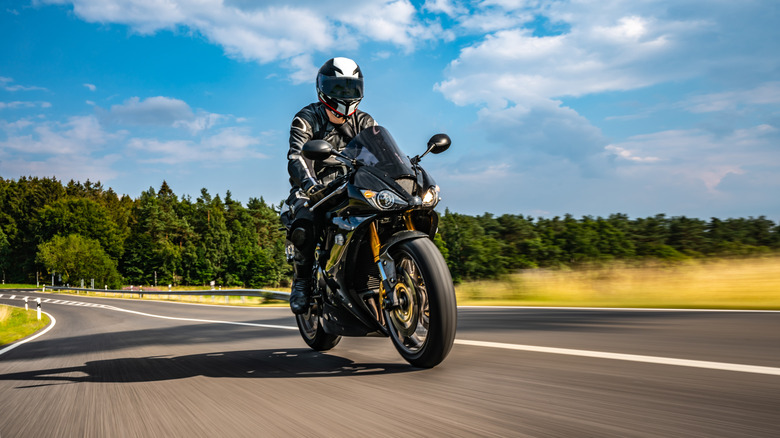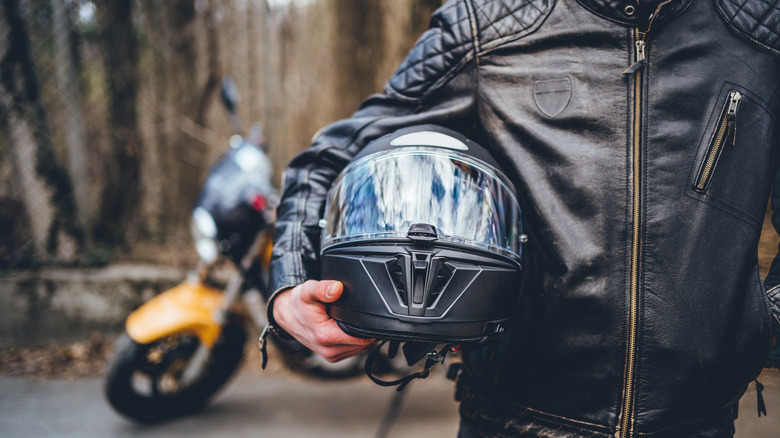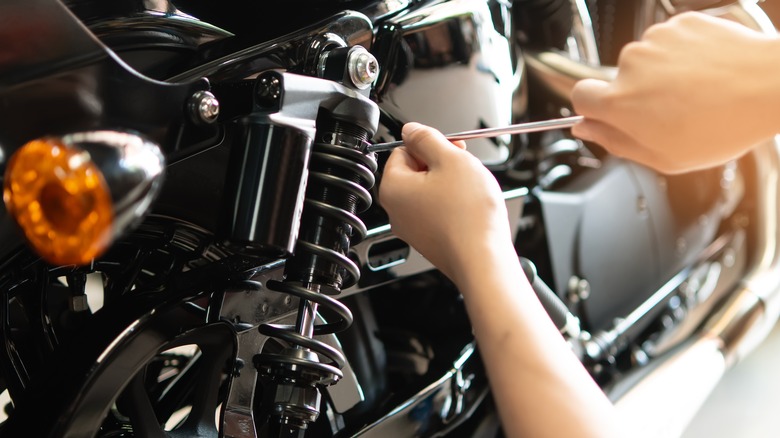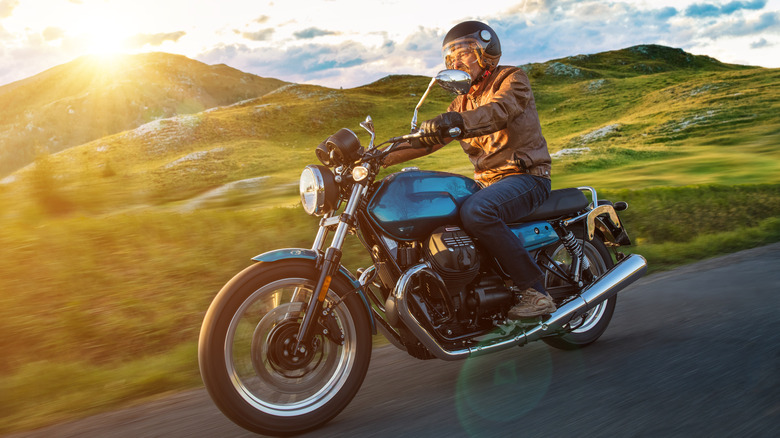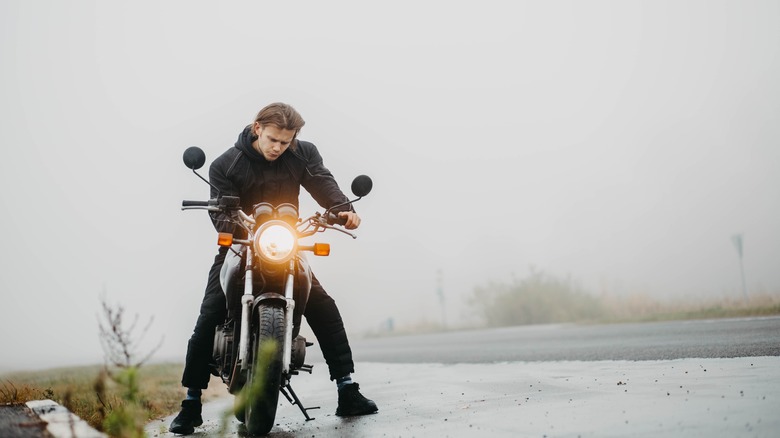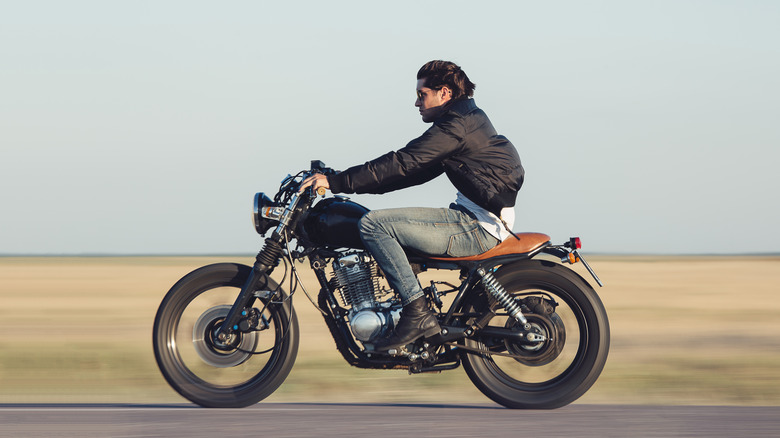5 Common Mistakes People Make When Riding A Motorcycle
Riding a motorcycle is fun. It provides a unique combination of freedom, speed, and closeness to the open road that few other activities can match. But the same things that make motorcycling exciting can also make it dangerous. Each time a rider gets on their bike, they face a series of risks that are different from those encountered when driving a car. In fact, despite being 3% of all registered vehicles, motorcyclists accounted for 14.6% of all fatalities on the road in 2022, according to the National Safety Council.
While there are important tips every new motorcycle rider should know, experienced riders can sometimes make mistakes, too — so whether you're a seasoned rider honing your skills or a newbie looking to explore the roads on two wheels, understanding these common mistakes can significantly improve your safety and enjoyment. Some of them are things you probably didn't even realize were mistakes. Even after ten years of riding motorcycles, I still find myself making and correcting mistakes. Constantly learning is just the nature of riding bikes. In the spirit of sharing what I've learned over the years with fellow riders, I have tried to pack as much detail as I can to identify, understand, and correct motorcycling mistakes. So, here are five of the most common ones.
Not wearing proper gear
When riding a motorbike, wearing the right gear is more than just following the law or being comfortable. In the event of a crash, your gear is the only line of defense that could mean the difference between minor injuries and life-altering consequences. So, here are the most critical gear every rider should prioritize.
A helmet is not just a legal requirement — it's a lifesaver. Whether it's a traumatic brain injury, facial scarring, or even death, the right helmet can dramatically reduce these risks. While options vary, prioritize a helmet that meets safety standards like DOT, ECE, or Snell. Choose a full-face helmet if possible; it offers the best protection by covering the entire head and face, protecting your skull, brain, and face from direct impacts and debris.
In a crash, your hands are likely to hit the ground first, risking severe injuries like broken wrists and mangled fingers, so proper motorcycle gloves are also a must-have. Make sure the ones you choose are reinforced and armored, to protect against road rash and absorb impacts. You will also need boots. A good pair of bike boots can prevent ankle fractures and keep your feet securely attached to your body, and it's even better if they come with non-slip soles, as falling over in public can be embarrassing. Finally, make sure you don't underestimate the importance of a good jacket with armor for the shoulders, arms and back. Spinal injuries can be devastating and irreversible.
Overlooking motorcycle maintenance
Riders frequently make the costly error of failing to maintain their motorcycles. There are must-know tips for motorcycle maintenance every rider should be aware of, but here's a rundown of the most common things to keep in mind.
Oil is the engine's lifeblood — it lubricates moving parts, decreases friction, and helps to dissipate heat — so regular engine oil changes are one of the most important parts of motorcycle maintenance. Check out Motorcyclist Magazine's video on changing motorcycle oil and filter for a step-by-step guide. Tire maintenance is also vital. Proper tire pressure gives you optimal contact with the road, improving the bike's stability and braking efficiency. Proper tread depth is also important for safe motorcycling, especially in wet conditions, as it helps to channel water away from the tire's surface, preventing aquaplaning, which can lead to a nasty crash. In the same vein, you should make sure your brake pads are in good condition. It's good practice to look after your battery, particularly for motorcycles that are not used every day — and while it's simple to bump-start a motorcycle, it can be very embarrassing.
The chain and sprockets must be inspected, cleaned, and oiled to work properly. Neglecting the chain can result in difficult gear shifts, increased wear, and, eventually, chain or sprocket failure. Adjusting the chain slack on your motorcycle is also a good skill to have. Fluid levels (brake, coolant, and transmission fluids) should also be checked regularly and topped up as needed. Prevention is always better than cure.
Not practicing emergency maneuvers
Motorcyclists are always learning, so honing and upgrading your skills is not only advantageous but also necessary. My guess is that motorcyclists often don't bother learning new techniques or practicing emergency maneuvers because we tend to forget the very specific benefits they bring. We also tend to forget that regularly putting our skills to the test increases our confidence on the road. Failure to do this can manifest as hesitation or delayed reactions at critical points — increasing the chance of an accident.
Speaking of reactions, given how frequent accidents are with motorcycles, motorcycling requires constant vigilance and the ability to react very quickly, and practicing maneuvers like emergency braking, swerving, and countersteering is the only way to improve.
This becomes even more important as you switch motorcycles, since each motorcycle has distinct characteristics that can have a big impact on how the bike behaves when performing an emergency maneuver. Practicing these moves is also particularly important for riders who live in areas with seasonal weather differences, like freezing winters or wet springs — emergency maneuvers are handled differently in different road conditions.
Ignoring weather conditions
Ignoring the weather can be extremely dangerous for motorcyclists — you need to adjust your riding and clothing according to conditions. If you're riding in the rain, you'll be on slippery roads with limited visibility. Use waterproof gear when possible, and have tires suitable for the wet, since they divert water away and have a much better contact with the road surface.
For many riders, "weather conditions" stop at rain, forgetting that things like fog drastically reduce visibility, too. Ensure your fog lights are on and wear high-visibility clothes. Keep in mind that strong winds and gusts can also unsettle a motorcycle, especially on open sections of road or bridges. You should be prepared to lean into the wind or change your riding line to compensate.
You really don't want to know what hypothermia is like, or the stiffness of limbs and joints you get when riding in cold weather. Layered thermal clothing is a must for the winter months, and you might also want to consider installing handlebar heaters. At the other end of extreme temperature is the kind of heat that can cause dehydration and weariness. Besides taking a break to drink some water, wearing vented riding gear is a smart solution, too.
Poor technique and habits
If you're riding a motorcycle, you might as well learn how to ride one properly. By properly, I don't mean there's a one specific way to ride motorcycles, the important thing is to have fun. That being said, motorcycles have been around for more than a century, and we've learned that certain habits and techniques help us ride our motorcycles more efficiently and safely. I wholeheartedly recommend taking courses from places like the Motorcycle Safety Foundation (MSF), regardless of experience, because they help you identify and eliminate common bad habits, and help you learn better techniques to incorporate into your riding. MSF's advanced rider course teaches you everything from how and when to use the rear brake on your motorcycle to advanced cornering and crash avoidance. In fact, according to Devitt Insurance, riders who have taken advanced rider courses are involved in fever collisions per mile than riders who have not.
